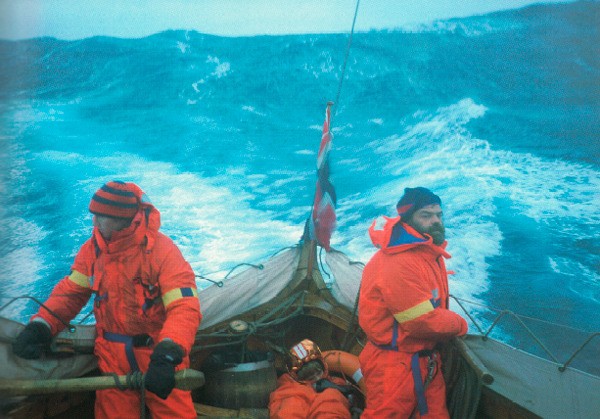When Jonathon Moses set to work repairing a dilapidated sailing boat in 1984, he had no inkling that he would soon be a crew member aboard a boat replicated from Viking lore, retracing the tumultuous path Norse explorer Leif Erikson had sailed centuries prior.
The Saga Siglar (meaning “sailor of the sagas”) was a 54-foot knarr, a replica of an 11th century Viking boat. Moses explained that no images of a knarr existed aside from the descriptions provided in sagas and the remnants of one that had sunk off the coast of Denmark.
“Nobody had ever rigged one; nobody had ever seen one before,” said Moses.
Though several Viking boats had been discovered, these were used for burials and warring parties and were not designed to handle sea voyages.
The knarr was designed specifically to handle the rough waters of the North Sea, and was used to freight goods along the trade routes and to settle various areas.
In the early 1980s, Saga Siglar captain Ragnar Thorseth, known as “Norway’s last Viking,” began planning his round-the-world sail. He had it in mind to replicate the knarr, and enlisted the help of Moses after the two frequented the same museum seeking information in rigging a centuries-old boat.
The two worked for two years with a team of fellow enthusiasts to accurately reconstruct the knarr. Upon its completion, 700 people rolled the boat from the forest to the sea on logs, just as would have been done centuries prior.
In 1984, on the anniversary of a battle which had united Norway 800 years prior, King Olav shared a ceremonial drink with the men before sending them off on their historic expedition.

Moses, who divides his time between Norway and Langley, will present a slideshow and discussion of his journey titled “A Viking Adventure” at 6 p.m. Wednesday, June 3 at the Northwest Language Academy.
During his presentation, Moses will discuss highlights of the journey which Thorseth himself described as “a pretty hair experience,” including their exploration of areas such as the Faroe Islands, L’Anse aux Meadows, Iceland and Greenland.
He’ll also touch upon such climactic moments as the 15-hour hurricane the crew encountered between Greenland and Canada, which left the men fearful for their lives, including Thorseth who tethered his 11-year-old son to his side.
“That was pretty creepy,” Moses said of surviving the hurricane. “But it also showed how well-built the boat is.”
Throughout the journey, the sailors used traditional techniques when possible, such as throwing diesel fuel on the water as the Vikings used whale oil. However, they used modern technologies for safety and navigation. A film crew followed the boat for much of the journey, and several books have been written to document the expedition.
The Saga Siglar sailed until 1985, when it sank in a storm just off of the coast of Spain. There were no casualties.
Moses’ presentation is a part of Nordic Midsommarfest, a series of events celebrating the summer traditions of Nordic communities.
The main Language of Food event will take place on Saturday, June 13 and will include a dinner, celebration and performances by Nordic artists.
The most enjoyable aspect of the voyage, Moses said, was the unique experience of traveling throughout the North Sea, meeting residents of isolated and ancient communities, fishing in abundant waters and viewing incredible vistas.
“When you landed in a new place you’d just buy new clothes,” Moses said of traveling throughout the North Sea. “You were so wet and smelly and exhausted, and delighted to have made it ashore and made it alive. It was an emotional roller coaster.”


